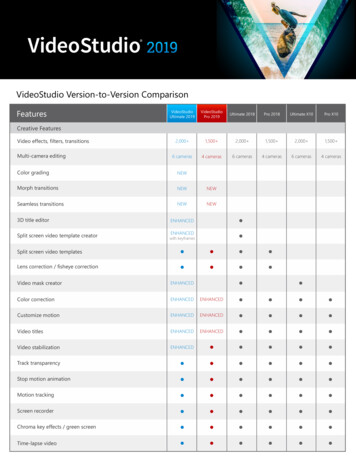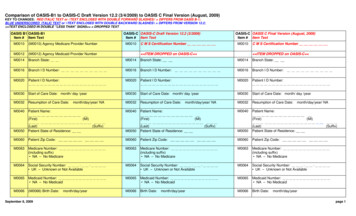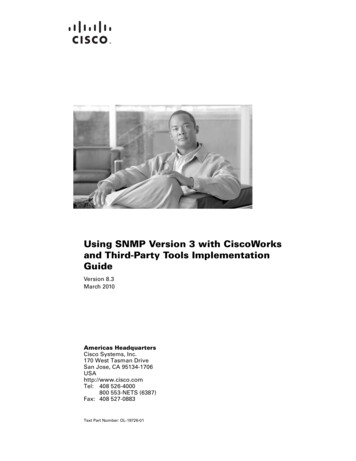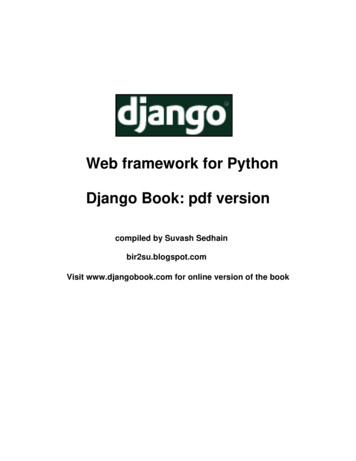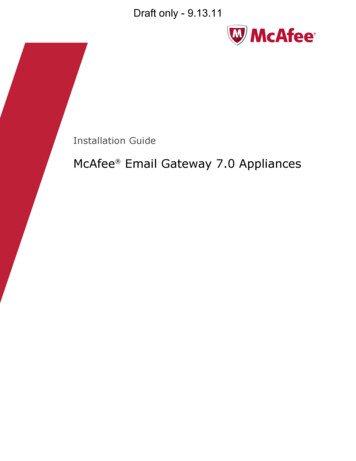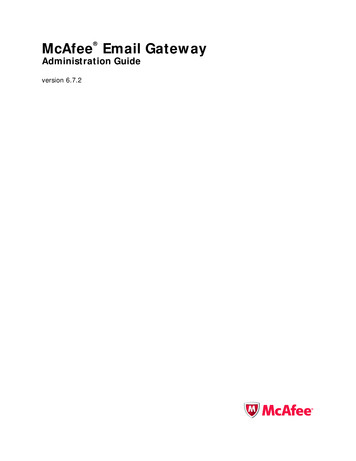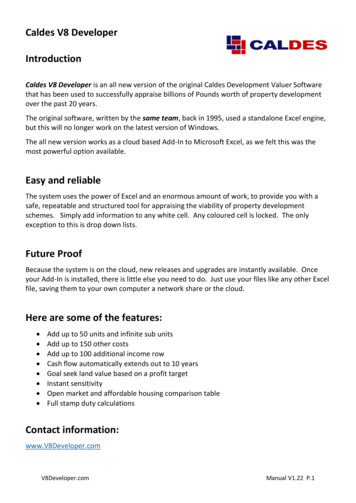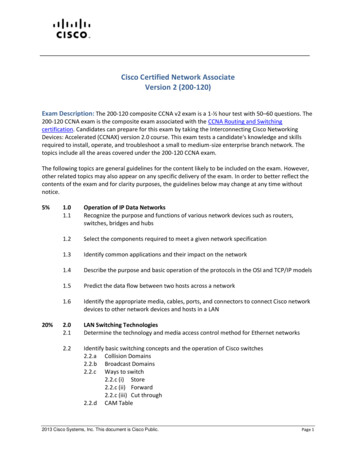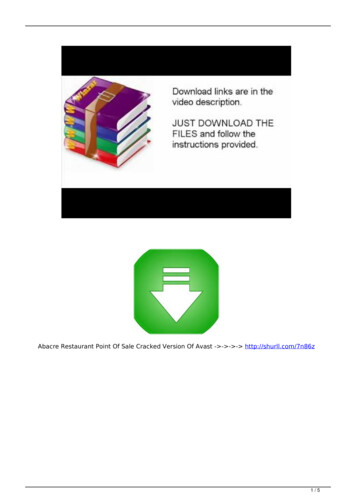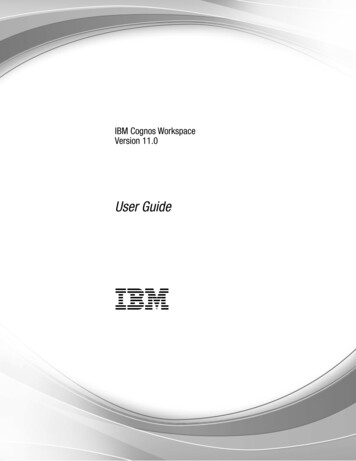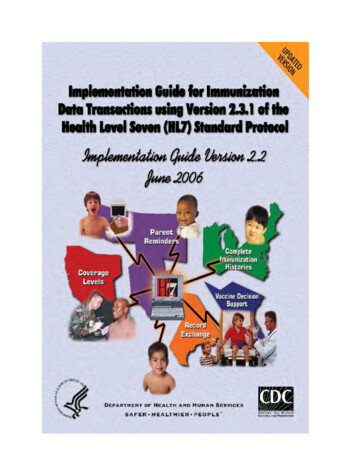
Transcription
Last Reviewed February 2016
Implementation Guide for Immunization Data Transactionsusing Version 2.3.1 of the Health Level Seven (HL7)Standard ProtocolImplementation Guide Version 2.2June 2006Centers for Disease Control and PreventionNational Center for Immunization and Respiratory DiseasesImmunization Services DivisionImmunization Information Systems Support BranchDEPARTMENT OF HEALTH AND HUMAN SERVICESSAFER HEALTHIER PEOPLETM
Version 2.2 June 2006 NotesThis document replaces previous National Immunization Program (NIP) Guidelines for Immunization DataTransactions versions dated September 2002 and earlier. This version 2.2 (referenced herein as theGuide) incorporates changes to the 2002 Guide. The revised, added, or deleted material is indicated byvertical lines in the margin, and is summarized in the table below the contact information following thissection. Additionally, Appendix 5 provides additional narrative and shows the new material and previousversion's materialAny needed additions or revisions to the Guide have been coordinated with the American ImmunizationRegistry Association (AIRA). Previous changes were coordinated with the Committee on ImmunizationRegistry Standards for Electronic Transactions (CIRSET), whose functions have now been merged withAIRA. Members have indicated their intention to implement the Guide as written and to resist adding Zsegments or otherwise changing the implementation to one that is not consistent with this document.To claim conformance with this Guide, registries must support the four immunization data transactionmessages described on page 3: the VXQ (Query for Vaccination Record), the VXR (Response toVaccination Query Returning the Vaccination Record), the VXX (Response to Vaccination QueryReturning Multiple PID Matches), and the VXU (Unsolicited Vaccination Record Update). As necessary,registries should support the use of ACK and QCK messages described in the Guide. For registries thatare developing HL7-based electronic VAERS reporting, the ORU message definition supplied in theGuide is the standard for compliance. Supporting all four VX* message types is also a recommendedrequirement for registry certification.Registries are encouraged to implement HL7 communication with providers and data sources other thanregistries. In these cases, the four VX* messages mentioned above may alone prove insufficient. ADTmessages are discussed in this document and are available for communication with providers and othernon-registry data sources. However, even with non-registry data sources, the VX* messages arepreferred when possible and appropriate.A conformant registry must also follow the HL7 protocol as described in the standard and further definedin this Guide. Registries should include segments and fields required by HL7 exactly as defined by thestandard and described in this Guide. For example, the third field in the Patient Identification Segment(PID-3) is required by HL7 to contain the list of patient identifiers, identified by type code. It can retain anunlimited number of identifiers. Registries should not restrict the utility of this field in their implementationby arbitrarily limiting the supported identifiers to their own registry identifier. Other functions describedherein, such as reporting vaccine adverse events using HL7, are provided as information to registries. Ifthese functions are implemented, however, registries should follow the guidelines as written.The HL7 2.3.1 standard version is the standard for registries and for registry certification. XML versionsof the HL7 versions 2.3, 2.4 and 2.5 exist and are used by registries. These cannot, however, beconsidered a substitute for the standard version embodied in this document. Any registry using an XMLapproach has the responsibility to be able to communicate with other registries or providers using the HL7standard version. In order to be certified, any registry using an XML approach must be able to receive,process, and respond using the standard HL7 2.3.1 message test sets.This Guide is intended for use by immunization registries that want to participate in a strictly-definedrecord exchange agreement that limits the amount of optionality normally expected when using the HL7standard. The Guide describes the most frequently used segments in their entirety, while giving aminimum description of segments containing only a few useful fields for registries. The Guide fullydescribes the fields within the segments used frequently by immunization registries, while the others areomitted in this document. With this limited scope, this Guide can in no way serve as a substitute for athorough study of the entire set of HL7 specifications for electronic data interchange in health careenvironments. For more complete information about HL7, visit the website at www.hl7.org
For information about HL7, contact:For information about this Guide, contact:Health Level Seven3300 Washtenaw Avenue, Suite 227Ann Arbor, MI 48104-4250Phone: (734) 677-7777Fax:(734) 677-6622E-Mail: hq@hl7.orgWebsite: www.hl7.orgRon Van Duyne404-639-8962rvanduyne@cdc.govFor information about the American ImmunizationRegistry Association, visitwww.http://www.immregistries.orgWarren Williams404-639-8867wxw4@cdc.govImmunization Information SystemsSupport BranchImmunization Services DivisionNational Center for Immunizationand Respiratory DiseasesCenters for Disease Control and PreventionPhone: (404) 639-8245Fax:(404) 639-8171Website: www.cdc.gov/nip/registryThis Implementation Guide is in the public domain and may be used and reprinted without permission;citation as to source, however, is appreciated. copies may be downloaded from the National Center forImmunization and Respiratory Diseases websitehttp://www.cdc.gov/nip/registry/st terr/tech/tech.htm#stds.Summary of Revised, Added, or Deleted Material (from Version 2.1, September 2002)(Note: See Appendix 5 for narrative about updates listed below)Page(s) Page(s) Page#Section Number - Summary of Change in Material/TopicDeleted InsertedFollows titlepageFollowsNotes3165275.1-75.275.180A1-12 toA1-17A1-24 toA1-27A1-26 toA1-27A5-1 toA5-2Version 2.2 NotesContact Information updateImmunization Data Transaction Messages: clarification7.2.1 Unsolicited Transmission of an Observation (ORU) Example VAERS ORUMessage: VAERS Item 2 new LOINC for sibling replacing separate LOINCs forbrother and sister3.3.3 - PV1 Segment clarification re: VFC or Mediciad Eligibility7.3.2.4 - OBX Observation sub-ID for Combination vaccines with possibleseparate VISs for individual vaccine components (page 75.2 continues old text)3.2 Patient Administration Message Definitions & Use of OptionalAdmission/Discharge/Transfer (ADT) Messages: clarificationHL7-defined Tables 0227 & 0292 - Current MVX & CVX code tables replace olderversionsNIP defined Table NIP003 - Observation Identifiers: Dose Number forCombination Vaccines & Vaccine Component (of a combination vaccine)clarification & observation examples furnishedNIP defined Table NIP003 - Observation Identifiers: Examples furnished forVaccines Due Next & VAERS ORU Message; new LOINC for sibling replacingseparate LOINCs for brother and sister for VAERS ORU MessageAdded narrative about updates
TABLE OF CONTENTSHL7 DEFINITIONS. 1BASIC MESSAGE CONSTRUCTION RULES. 2IMMUNIZATION DATA TRANSACTION MESSAGES. ANCE (IN1) SEGMENT .58INSURANCE ADDITIONAL INFORMATION (IN2) SEGMENT .58INSURANCE ADDITIONAL INFORMATION, CERTIFICATION (IN3) SEGMENT.58PHARMACY/TREATMENT ORDERS . 594.3.14.8.34.8.147.3PATIENT IDENTIFICATION (PID) SEGMENT .39PATIENT ADDITIONAL DEMOGRAPHIC (PD1) SEGMENT .47PATIENT VISIT (PV1) SEGMENT THE PV1 SEGMENT IS USED TO SEND VISIT-SPECIFICINFORMATION. .51NEXT OF KIN (NK1)/ASSOCIATED PARTIES SEGMENT .54FINANCIAL MANAGEMENT MESSAGE SEGMENTS . 586.4.66.4.76.4.84.8FILE HEADER (FHS) SEGMENT .35FILE TRAILER (FTS) SEGMENT .36BATCH HEADER (BHS) SEGMENT .37BATCH TRAILER (BTS) SEGMENT .38PATIENT ADMINISTRATION MESSAGE SEGMENTS . 393.3.23.3.93.3.36.4MESSAGE HEADER (MSH) SEGMENT.20MESSAGE ACKNOWLEDGMENT (MSA) SEGMENT .25ERROR (ERR) SEGMENT .27QUERY ACKNOWLEDGMENT (QAK) SEGMENT .28QUERY DEFINITION (QRD) SEGMENT .29QUERY FILTER (QRF) SEGMENT .32HL7 BATCH PROTOCOL. 352.24.112.24.122.24.132.24.143.319MESSAGE CONTROL SEGMENTS . 202.24.12.24.22.24.32.24.222.24.42.24.52.23.3VXQ Example #1 (Query with many identifiers). 5VXQ Example #2 (Query with only a name identifier). 5RESPONSE TO VACCINATION QUERY RETURNING MULTIPLE PID MATCHES (VXX).6VXX Example (Response with many matches). 6RESPONSE TO VACCINATION QUERY RETURNING THE VACCINATION RECORD (VXR) .7VXR Example #1 (Response to VXQ Example #1). 7VXR Example #2 Returning Vaccines Due Next Data from the Registry Algorithm . 9UNSOLICITED VACCINATION RECORD UPDATE (VXU) .11VXU Example #1 (Message with only required fields valued) . 11VXU Example #2 (Unsolicited update showing use of optional segments) . 11UNSOLICITED TRANSMISSION OF AN OBSERVATION (ORU) .13Example VAERS ORU Message. 15ACKNOWLEDGMENT MESSAGES (WITH ERRORS OR FINDING NO MATCH TO QUERY PARAMETERS)18General Acknowledgment Example #1 (ACK with error) . 18Query General Acknowledgment Example #2 (QCK with no matching records found). 18COMMON ORDER (ORC) SEGMENT .59PHARMACY/TREATMENT ROUTE (RXR) SEGMENT.62PHARMACY/TREATMENT ADMINISTRATION (RXA) SEGMENT .63OBSERVATION REPORTING SEGMENTS . 707.3.2OBSERVATION/RESULT (OBX) SEGMENT .73
2.24.15 NOTES AND COMMENTS (NTE) SEGMENT. 793.3.13.3.8ADMISSION/DISCHARGE/TRANSFER AND ACKNOWLEDGMENT (ADT/ACK) - ADD PERSONINFORMATION (EVENT A28) .81ADMISSION/DISCHARGE/TRANSFER AND ACKNOWLEDGMENT (ADT/ACK) -DELETE PERSONINFORMATION (EVENT A29) .81ADMISSION/DISCHARGE/TRANSFER AND ACKNOWLEDGMENT (ADT/ACK) -MERGE PERSONINFORMATION (EVENT A30) .82ADMISSION/DISCHARGE/TRANSFER AND ACKNOWLEDGMENT (ADT/ACK) -UPDATE PERSONINFORMATION (EVENT A31) .82EVENT TYPE (EVN) SEGMENT.82MERGE PATIENT INFORMATION (MRG) SEGMENT .84APPENDIX 1:CODE TABLES. 1APPENDIX 3:RECOMMENDED CORE DATA SET FOR IMMUNIZATION REGISTRIES. 1APPENDIX 4:VACCINE ADVERSE EVENT REPORTING SYSTEM (VAERS) . 13.2.283.2.293.2.303.2.31APPENDIX 5: NARRATIVE REVIEW OF REVISED, ADDED, OR DELETED MATERIAL SHOWINGNEW AND PREVIOUS VERSIONS WITH SPECIFIC CHANGES MADE (UNLESS OTHERWISENOTED) 1REVISED, ADDED OR DELETED TEXT (VERSION 2.2, JUNE 2006) PAGE 3 . 1IMMUNIZATION DATA TRANSACTION MESSAGES. 1IMMUNIZATION DATA TRANSACTION MESSAGES. 1REVISED, ADDED OR DELETED TEXT (VERSION 2.2, JUNE 2006) PAGE 75.1 . 2REVISED, ADDED OR DELETED TEXT (VERSION 2.2, JUNE 2006) PAGE 80 . 33.2PATIENT ADMINISTRATION MESSAGE DEFINITIONS. 4ii
HL7 DefinitionsMessage: A message is the entire unit of data transferred between systems in a single transmission. Itis a series of segments in a defined sequence, with a message type and a trigger event.Segment: A segment is a logical grouping of data fields. Segments within a defined message may berequired or optional, may occur only once, or may be allowed to repeat. Each segment is named and isidentified by a segment ID, a unique 3-character code.Field: A field is a string of characters. Each field is identified by the segment it is in and its positionwithin the segment; e.g., PID-5 is the fifth field of the PID segment. Optional data fields may be omitted.Whether a field is required, optional, or conditional in a segment is specified in the segment attributetables. The designations are: R Required, O Optional, C Conditional on the trigger event or on someother field(s). The field definition should define any conditionality for the field: X Not used with this triggerevent, B Left in for backward compatibility with previous versions of HL7. A maximum length of the fieldis stated as normative information. Exceeding the listed length should not be considered an error.Component: A component is one of a logical grouping of items that comprise the contents of a coded orcomposite field. Within a field having several components, not all components are required to be valued.Item number: Each field is assigned a unique item number. Fields that are used in more than onesegment will retain their unique item number across segments.Null and empty fields: The null value is transmitted as two double quote marks (“”). A null-valued fielddiffers from an empty field. An empty field should not overwrite previously entered data in the field, whilethe null value means that any previous value in this field should be overwritten.Data type: A data type restricts the contents and format of the data field. Data types are given a 2- or 3letter code. Some data types are coded or composite types with several components. The applicabledata type is listed and defined in each field definition. Appendix 2 provides a complete listing of datatypes used in this document and their definitions.Delimiters: The delimiter values are given in MSH-2 and used throughout the message. Applicationsmust use agreed upon delimiters to parse the message. The recommended delimiters for immunizationmessages are CR Segment Terminator; Field Separator; Component Separator; & SubComponent Separator; Repetition Separator; and \ Escape Character.Message syntax: Each message is defined in special notation that lists the segment 3-letter identifiers inthe order they will appear in the message. Braces, {}, indicate that one or more of the enclosed group ofsegments may repeat, and brackets, [ ], indicate that the enclosed group of segments is optional.Z segments: All message types, trigger event codes, and segment ID codes beginning with Z arereserved for locally defined messages. No such codes will be defined within the HL7 Standard. Theusers of this guide have agreed to eliminate Z segments from their implementations in order to produce astandard method that will be used nationally to transmit immunization data.1
Basic Message Construction RulesEncoding Rules for Sending- Encode each segment in the order specified in the abstract message format.- Place the Segment ID first in the segment.- Precede each data field with the field separator.- Encode the data fields in the order and data type specified in the segment definition table.- End each segment with the segment terminator.- Components, subcomponents, or repetitions that are not valued at the end of a field need not berepresented by component separators. The data fields below, for example, are equivalent: XXX&YYY&& is equal to XXX&YYY ABC DEF is equal to ABC DEF Encoding Rules for Receiving- If a data segment that is expected is not included, treat it as if all data fields within were not present.- If a data segment is included that is not expected, ignore it; this is not an error.- If data fields are found at the end of a data segment that are not expected, ignore them; this is not anerror.2
IMMUNIZATION DATA TRANSACTION MESSAGESInformation systems that maintain immunization records need to be able to transmit patient-specificimmunization histories electronically to other systems to allow healthcare providers to have access tothese records at the time health care is given. Electronic tracking of immunization records also allowsproviders to track their own progress in reaching age-appropriate immunization coverage levels easilyand efficiently.The data transmissions between registries will occur as the result of four activities: (1) a query from onesystem for a patient's vaccination record that is held in another system (VXQ); (2) a response to a querycontaining multiple patient "matches" to the query, but not returning vaccination records (VXX); (3) aresponse to a quer
registries. In these cases, the four VX* messages mentioned above may alone prove insufficient. ADT messages are discussed in this document and are available for communication with providers and other non-registry data sources. However, even with non-registry data sources, the
